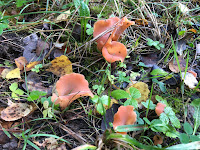A contributing author, Jamie Zawinski, refers us to a collection of nominations from scientists, historians, programmers and journalists for the most consequential pieces of code, which affects and informs society as much as any custom, convention or creation, though more aloof by design with few able to incant such spells.
 Though not exhaustive, the list and associated stories are pretty comprehensive and cover the classic milestones (often taken for granted) starting with the invention of the programmable loom in the early eighteenth century to JPEGs, GeoCities, RSS feeds, wikis and a whole host of viruses. One rather elegant vector we’re introduced to is the recursive single line of code (pictured) that is called a fork bomb or a wabbit for its prolific nature. This string of instruction (these are not the magic words, please don’t type them) launches a denial-of-service attack by repeating itself until all system resources have been taken up.
Though not exhaustive, the list and associated stories are pretty comprehensive and cover the classic milestones (often taken for granted) starting with the invention of the programmable loom in the early eighteenth century to JPEGs, GeoCities, RSS feeds, wikis and a whole host of viruses. One rather elegant vector we’re introduced to is the recursive single line of code (pictured) that is called a fork bomb or a wabbit for its prolific nature. This string of instruction (these are not the magic words, please don’t type them) launches a denial-of-service attack by repeating itself until all system resources have been taken up.
Wednesday 16 October 2019
really simple syndication
catagories: 💡, 💾, networking and blogging
Tuesday 15 October 2019
roughly the kinetic energy of a well-pitched baseball
In operation from 1986 to 1993, the Fly’s Eye ultra-high-energy cosmic ray observatory in the desert of western Utah detected on this day in 1991 a particle whose excited state was off-the-charts with nothing remotely close ever seen again (see also), though similar subsequent events suggest that it is not a malfunction. This anomaly was dubbed the “Oh-My-God particle” (not to be confused with the God Particle) due to the wallop it packed. Though this probably does not sound like an astronomical amount, to take it in context, the importance of this reading begins to take shape.
The signal represented the energy carried by a single photon—as if a beam of light could nudge something aside, concentrated on one particle and represents something magnitudes stronger than any radiation measured from the gamma bursts of distant exploding galaxies (by some twenty million fold) and twice again as much as the CERN is able to create. The cosmic ray, to have attained the title heft, was propelled along at near the speed of light (one-sextillioneth shy—that is, nine-nine percent followed by twenty-one significant digits, short scale). Were it possible to boost the particle through the infinitesimal fraction, it would have the kinetic equivalent to the potential (chemical energy) of a small automobile on a full-tank of gasoline. The Oh-My-God particle and others approaching this class originate from the direction of the asterism Ursa Major though there is no consensus on the source.
Monday 14 October 2019
prismatic
 Via the always engaging Everlasting Blört, we are treated to the AI-aided renderings of a digital artist called Matchue and his repertoire of experimental generative compositions with this lovely vignette of New York City expressed, stylised after the Cubist movement, evoking especially the Simultaneous Windows series of painter Robert Delaunay (*1885 – †1941).
Via the always engaging Everlasting Blört, we are treated to the AI-aided renderings of a digital artist called Matchue and his repertoire of experimental generative compositions with this lovely vignette of New York City expressed, stylised after the Cubist movement, evoking especially the Simultaneous Windows series of painter Robert Delaunay (*1885 – †1941).
gemeine stinkmorchel

also in extended use
From the Guardian’s Language Desk, we are treated to a preview of all the superlative contenders vying, no holds barred of course for what the surplus of the year could still deliver, to be the term that carries 2019.
 From prorogue to cancel-culture to the extremely well sourced phenomenon of sadfishing, the latest behavioural term to employ the suffix and referring to an appeal through trauma to build and uphold a following, which word would you champion or have brought into the running? Judging by the most queried dictionary definitions—including retrologisms like ruthful for having contrition and compassion over the more common absence of it—exonerate and furlough might also make the list.
From prorogue to cancel-culture to the extremely well sourced phenomenon of sadfishing, the latest behavioural term to employ the suffix and referring to an appeal through trauma to build and uphold a following, which word would you champion or have brought into the running? Judging by the most queried dictionary definitions—including retrologisms like ruthful for having contrition and compassion over the more common absence of it—exonerate and furlough might also make the list.
catagories: 💬
low-res
catagories: 🇯🇵, 📐, environment
Sunday 13 October 2019
pilzfund
H and I went foraging for mushrooms recently and though we’re not averaging a good return on edible specimens from the field, we are getting exposed to quite the menagerie of woodland types of fungi during our scavenging.
For all of its rather Lynchian baggage, the wood ear is very much edible—if not a bit bland unseasoned, and is a staple for umami flavourant in Asian cuisine. Please click on the images for more detail. The pharmacological merit of the fungus is currently being studied, research suggesting that its palliative use in folk medicine was not far off.















